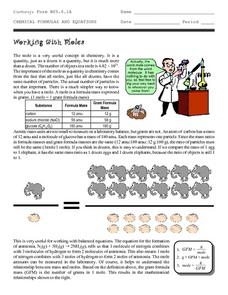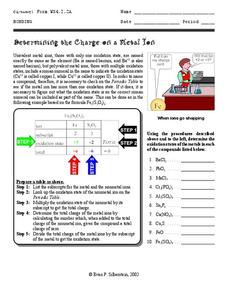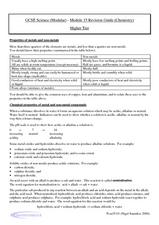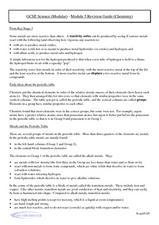Curated OER
Combination of Atoms
In this atoms worksheet, students review protons, neutrons, electrons, molecules, compounds, and ions. This worksheet has 10 fill in the blank and 3 problems to solve.
Curated OER
Water Equilibria
For this water equilibria worksheet, students calculate the pH of solutions, they fill in a table with the type of acid or base given a compound and it's concentration and they calculate approximate solubilities for salts.
Curated OER
Acids and Bases
In this acid and base worksheet, students read about the characteristics of acid and bases, the pH scale and neutralization reactions. Students match 10 terms with their definitions related to acids, bases and pH, they identify acids and...
Curated OER
Organic Chemistry Worksheet
In this organic molecules worksheet, students classify organic compounds, they name organic compounds using the IUPAC naming system, they complete chemical reactions of organic compounds, and they draw structural formulas of isomers.
Curated OER
Bonding
In this bonding worksheet, high schoolers read about the octet rule in bonding, ion notation, ionic bonds, covalent bonds and oxidation numbers. Students write 2 ion notations, they determine if 8 sets of ions will make compounds, they...
Curated OER
Different Minerals
In this minerals worksheet, students read about the relationship between elements, rocks and minerals. They experiment using 6 different colored gumdrops to represent 6 common elements. Students construct gumdrop and toothpick models of...
Curated OER
Working with Moles
In this moles activity, high schoolers read about mass, formula mass and moles. They calculate the masses of given numbers of moles of compounds and they calculate the number of moles of given masses of compounds.
Curated OER
VSEPR And Polarity
For this VSEPR theory worksheet, students evaluate the electron-pair geometry of organic and inorganic molecules. They construct Lewis structures and resonance structures for 17 compounds and complete 3 short answer questions.
Curated OER
Subject-Verb Agreement Rules
In this subject verb agreement worksheet, learners read information about subject-verb agreement and then identify the correct verb in a sentence, practice using delayed subjects, and underline the verb that agrees with the subject in...
Curated OER
Symmetry
In this symmetry worksheet, students use the alphabet to determine how many letters have a mirror plane, rotational axis, or an inversion center. Students determine the symmetry elements and the point group for different chemical...
Curated OER
Unit 4 - Periodic Table
There are 17 multiple choice questions on this periodic table test. The focus is on properties of the elements by group and period. The exam is not formatted well, making it a little difficult to read. There is also a typographical...
EngageNY
Modeling a Context from a Verbal Description (part 1)
When complicated algebraic expressions are involved, it is sometimes easier to use a table or graph to model a context. The exercises in this lesson are designed for business applications and require complex algebraic expressions.
Curated OER
Practice: Word Problems
Congratulations, you've just hit the word problem jackpot! Covering an incredible range of topics from integers and fractions, to percents, geometry, and much more, this collection of worksheets will keep young mathematicians busy...
Curated OER
Final Exam Review: College Algebra
In this final exam review worksheet,s students solve systems of equations, polynomials and factor quadratic equations. They identify the slope of a line and write linear equations. Students use Cramer's rule, graphing, substitution,...
Curated OER
Determining the Charge on a Metal Ion
In this metal ion worksheet, learners follow the steps to determine the oxidation states of the metals in each of the given compounds. Students complete 10 problems.
Curated OER
More Practice on Lewis Structures and Formal Charges
In this chemistry worksheet, students practice creating the correct chemical compounds in theory using the lewis structures in the applied problems.
Curated OER
Oxyanions
In this oxyanions worksheet, students identify the common polyatomic ions. They write formulas and name polyatomic ions based on IUPAC rules.
Texas State Energy Conservation Office
Investigation: Blowing in the Wind
Using a simulated air sample, environmental or earth science pupils examine the components. You will need to prepare the faux air by using a hole punch and various colors of construction paper. Each color will represent a different...
Curated OER
Bond Type
At the top of the page are a reading passage and colorful diagram that depicts the tug-of-war that occurs between bonding molecules due to electronegativity. High school chemists fill in a chart with electronegativity values, the...
National Institute of Open Schooling
Chemical Bonding
Name is Bond, covalent bond. Through readings and answering questions, classes explore the different types of chemical bonds, their characteristics, valence shell electron pair repulsion theory, and atomic orbitals.
Curated OER
Revision Guide - Chemistry
Don't you wish you had the time to type up a study guide for your chemistry class? With this resource, there is no need! A chart comparing the properties of metals and non-metals tops the handout, followed by notes on the reactivity...
Curated OER
Metals and Non-Metals
A table of the physical properties of metals and non-metals opens this high-school chemistry handout. Also covered are the chemical properties of metals and non-metals, reactivity, and fossil fuels. There are no specific questions to...
Curated OER
How To Build a Planet From The Inside Out!
High schoolers read about the Spitzer Space Telescope and the technology used to learn about planet composition. They calculate the radius of a planet, the size of a planet, the average density of a planet and the likely core composition...
Curated OER
Module 5 Revision Guide - Chemistry
If you use this as an outline for your chemistry lecture on metals, your young chemists will absorb a well-rounded overview. This is not a learning exercise per se, but a useful summary of the behavior of metals. Save yourself some...

























